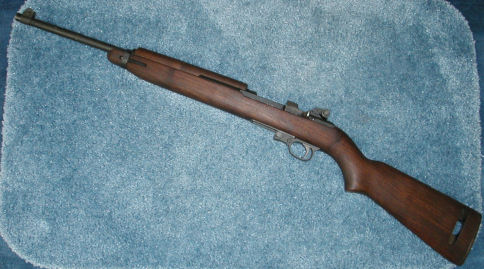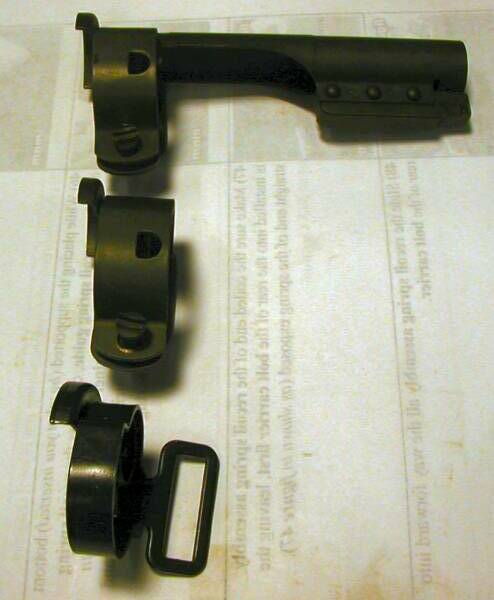M1/M2 Carbine
Functional Military History:
I have a “thing” for military firearms, particularly U.S. firearms, and even more particularly WWII weapons. My wife say it’s an addiction, I prefer to embrace it as a passion. Addiction or passion, I like em’, and I like em’ to work. One of my favorites is the M1 Carbine, for several reasons. First, there were a lot of them made, approximately 6,221,000 were made between September of 1941 and June of 1945. That means that there are still a few around to be had, along with a good supply of spare parts.
Secondly, they were manufactured by as many as nine primary manufactures including Winchester, the designer of the carbine, a juke box maker (Rock-Ola), a car/truck manufacturer (GM – Inland Division and Saginaw Division), a typewriter company (Underwood), a postal equipment maker (National Postal Meter), a car parts manufacturer (Standard Products), a maker of hardware and tooling (Quality Hardware), and a business machine and future computer company (IBM). There were several minor manufacturers of different components such as Singer, Buffalo Arms, and Marlin who made barrels. In addition, there were several variations, including a select fire model. Throughout it’s short but prodigious manufacturing run, many of the carbines components saw design changes spurred by reports from the war zones requesting improvements. All that makes for interesting opportunities for collecting, and study.
A third plus for the M1 carbine is that it is just fun to shoot. The .30 caliber round is fairly inexpensive, the gun is lightweight at around 5 lbs, not a lot of recoil, which makes for a good father son/daughter day at the range, and it works well. History you can shoot!
Technically speaking the carbine is a gas operated, air-cooled, roller lock weapon fed by a clip. The standard capacity of the clip was 15 or 30 rounds, however there were clips made in 5 and ten round capacities. The M1 and M1A1, which is the folding stock paratrooper model, were semi-auto fire only. The M2 and M3 variants were select fire weapons with a selector switch to go from semi-auto to full auto. The M3 variant was an M2 with an infrared night scope attached. Pretty slick technology for 1945, the night vision variant actually saw service against the Japanese toward the close of the war. Quite a surprise to the Japanese soldier used to sneaking around in the dark.
The design of the M1 came from a military request for a “light rifle” to replace the 1911 Colt as the side arm for combat officers, rear echelon, and support personnel. In 1941 Winchester won the design competition for that new weapon, and it was a new weapon. A small “pistol” caliber in a short barreled, shoulder fired semi-auto carbine, was new. Having a full-auto version was really new, the US had no other weapon in its arsenal like it. Although it was not designed for front line service it quickly found it’s way to the front. It’s light weight, and therefore the ability to carry a larger combat load, coupled with full auto made it a favorite of many a GI and Marine, it was second only in numbers in WW II to the M1 Garand. The M1/M2 saw service from WW II through Korea and into Vietnam.
As with anything new there was room for improvement, and there is nothing that will speed along improvements than being in the middle of a shooting war. There were numerous changes. Some changes were made to speed up production, some were made to make the gun function better under battle conditions. Just about every part in the gun saw some kind of change, some parts saw several changes. For example there are three major types and two changes in barrel band design alone. The first change to improve the function of holding the stock and handguard together, while the final change was to incorporate an attachment point for a bayonet, rumor has it the Marines wanted that one. There is not the space here to detail even the more significant changes, but amazingly enough, despite the many changes and the many manufacturers of guns and parts they all pretty much interchanged.
Collecting the M1 Carbine will keep you busy for a long time, partly because there were so many different manufacturers, and design/part changes to collect, and partly because the parts interchanged so well. With all these different pieces and parts, it did not take long in field armor depots, and re-arsenal facilities, as well as foxhole repairs to have all those pieces and parts intermixed. Just to make things that more interesting the re-arsenal depots had replacement parts, and upgrade parts that were manufactured by different companies than those who originally made them. By the time a carbine made it through re-arsenal it could have parts from a number of makers, none of which originally came in that particular serial number weapon, or were even part of the original manufacturers production.
After the US was done with the carbine as a service rifle and even during, many went to the South Korean army, the guns were sold to many other countries. Some guns were captured by the Chinese during the Korean police action, and copied. Many of these guns have found there way back home in the surplus market. It can be a challenge to get all the correct parts back into a particular receiver make and serial number. Doing so will definitely increase the value of the gun. It won’t shoot any different, but if you are like me, it makes a difference to know that you have it back like it was when it was first issued to that Marine, GI, or swabby.
It’s a military gun, it was designed to go through dirt, mud, gravel, rain and general abuse. For the most part it will keep on working having done bad things to it, keep it clean like you should since you don’t live in a foxhole and it will keep working for a long time. When things do go wrong it is usually caused by wear; sears, triggers, firing pins, maybe a slide spring or gas block. They generally are not too difficult to work on once you understand design and function. If you can’t fix the part, you can probably get a replacement part fairly inexpensively. I have not had many feeding problems, but be careful about what kind of mags you use, get military surplus if you can, some of the aftermarket mags have fit and feeding problems. Barrels don’t last forever either but are still available.
You can always tinker with it, smooth out the trigger a little, there are scope mounts that you can still get. I put a red dot scope on one with a muzzle brake and it makes it fun to hunt cans with. If you look hard enough there are still some gingerbread items available for it, synthetic stocks, and such. AGI has a very good armorers DVD on the M1/M2 if you want to learn more of the particulars.
There are some civilian copies still out there that I would strongly suggest staying away from the early ones, Iver-Johnson, Howa. They weren’t that good new, let alone used, and the parts do not interchange with the military versions. Auto Ordinance/Kahr Arms is producing a newer version that is supposed to be much better than the older knock offs, don’t know haven’t had a chance to test one. Maybe AGI can pull some strings.
If you have one of these old military warriors stuck in a corner or attic, take it out dust it off. Check out what you have, who made it, when was it made? Have it checked out for serviceability and safety, take it out and shoot a few rounds. You are holding a piece of US military history, and it still works, -- I love functional history. Chances are that someone’s son took it to war to preserve the freedom for you to stand there and fire those rounds. Respect it, don’t get complacent about it, it is too hard to get and just as hard to keep, both the gun and the freedom to shoot it.
If you would like to know more about the carbine you own or perhaps some other old US military firearm drop me an email, we specialize in restorations, and I am particularly fond of the M1 carbine.
Paul D. Smeltzer
Athensgunsmith@gmail.com
Published in GUN TECH September 2008
Articles and Publications written by Paul Smeltzer.
Click on Topic to bring up PDF file.
 | ||||||

